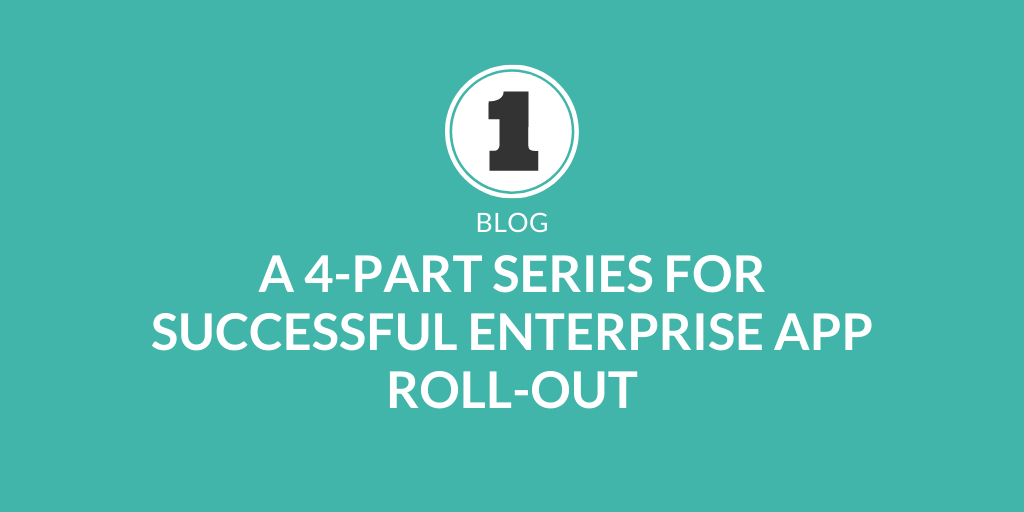When introducing a new product or service it’s just as important that your own organization and team buy-in to the program as much as the customer, especially when it comes to mobile apps and digitizing the customer experience. This will help create a thriving ecosystem, so that when your customers do begin on-boarding to the platform, it’s not a ghost town.
This four-part series will highlight a few helpful hints and ideas that can help you gain traction internally, get teams excited, and increase executive acclimation for a more spirited jump from the starting line.
So, where to begin?
First things first… clearly communicate objectives.
A strong internal communications plan will help your team become familiar with the product, service, expectations, benefits, and provide them with the personal investment they need to care *more about your mobile initiatives.
When it comes to mobile apps, you want a fair amount of early adoption. It’s important that you not only get your team using the platform as soon as possible, but that you also provide them with enough information. They need to know the ins and outs. That way, by the time your customer base crowds in, your team knows exactly how to support them.
Here are some tips that will guide you.
Define Key Initiatives
Every app or service has a purpose, right? Well, what can your platform offer your team? How will it benefit them, and how will it make their lives easier?
It helps to think of your team as the initial customer base. This will help you define key initiatives and outline what makes your app or service special. You must be able to define and state clear value propositions for everyone using your service, internally and externally.
This will help you establish clear program goals and mission statements. But, more importantly, it will instill a sense of pride and accomplishment in your crew, contributing to team success. They’ll see their hard work in action, and they’ll see how much value it can bring. Every service or product needs the full support of its team to succeed. Your app is no different.
Identify Influencers
When you’re new to the market, exposure means all the difference. If you get lucky, someone remarkably high-profile will discover your platform and promote it for you. That’s a good model for B2C apps, but for enterprises it gets a bit trickier.
So, find your own influencers from the inside. Look around, are there more social people in your group that can evangelize your mobile app customer program, your boss, director, or even someone from the C-Suite that can champion the cause and speak to the importance of providing a mobile-first customer experience.
Invite them to be early adopters with you and your team, clearly state the benefits, these will likely be numbers or facts types of people, then hopefully they will naturally promote your app across the organization, ultimately decreasing the barrier to internal on-boarding.

Work Around Important Dates
The ultimate deadline is - and always will be - your launch date. But you want to be sure you get everything perfect, leading up to it.
Sit down and hash your important dates and milestones and then build a plan around those key points. You’ll want to structure easy onboarding and training sessions, grant reporting deadlines, private and public tests, all around the date(s) you chose.
If there are internal campaigns, product launches, or events happening within your organization, assess the advantages (or disadvantages) of aligning to those milestones. Holidays, company dates, customer acquisitions, tradeshows and so on, no matter how big or what type, having a solid launch plan with dates that make the most sense for you, your team, your company, and your customers will help steer the ship.
Where to Get It and What to Do
Assuming your app is approved and available in stores at this point, you’ll want to go ahead and communicate that. What stores can the app be found in? What devices?
Instruct internal teams on how to download and install the app (yes this should be obvious, but sometimes…). Great! Now they have it on their phone, right?! Hopefully yes.
The next step is to encourage your first user groups to register and create a profile. Why? For the most holistic experience across your organization, for stakeholders, partners, and customers, is to have the most up to date information across the company reflected in the app.
The primary goal of a mobile customer experience app is to provide on-demand information for perpetual engagement beyond the walls of your business… so people, profiles, and places are significant. Your requests for on-boarding can be simple, but they are important.
Next Steps?
As soon as you have your internal communications game plan laid out, it’s time to take things up a notch. What better way to do that - or mark the occasion - than with a launch party? You’ve told your internal stakeholders and team members what the app is, and what it does… now show them!
In the next chapter, we’ll explore some ideas for a mini launch party that will keep the momentum going for your mobile app program well before the customer even gets involved.


